
Lengthy halachic responsum (over 30 lines) on the topic of the halachic suitability of mikvehs by the mighty gaon Rabbi Moshe Feinstein, to his disciple, the gaon Rabbi Ephraim Greenblatt. Characteristic autograph script, with erasures and additions and a signature at the end of the letter.
Rabbi Moshe Feinstein [1895-1986] was the leader of American Jewry. He was one of the leading halachic decisors in the period following the Holocaust, chairman of Agudat Yisrael’s Council of Torah Sages in the United States and head of Mesivtha Tifereth Jerusalem in New York. He is also known for his book series, Shu”t Iggerot Moshe .
Rabbi Ephraim Greenblatt [1932-2014] was a halachic decisor and author of Shu”t Rivevot Ephraim . He was one of the greatest halachic decisors of the past generation, and primary disciple of Rabbi Moshe Feinstein.
[1] leaf paper, official stationery. 21.5×28 cm.
Very fine condition. Fold marks. Several small tears, without lack.

Lengthy letter (approximately 40 lines) on the topic of the kosher status of mazon hamalkot [a type of honey produced by queen bees], and on the topic kiddush b’makom seudah , handwritten and signed by the mighty gaon Rabbi Shlomo Zalman Auerbach to the gaon Rabbi Eliezer Yehudah Waldenberg, one of the most prominent dayanim of recent generations.
At the beginning of the letter, Rabbi Shlomo Zalman thanks him for sending his book Tzitz Eliezer Part XI, and he warmly blesses him, ‘May [you] continue in [your] sacred path … to clarify and refine halachahs in serenity and joy …’
Later on in the letter, Rabbi Shlomo Zalman writes in his great humility, ‘I managed to look over a significant portion of [your] responsa, and although I had some thoughts about them, due to the hassle together with my laziness , it seems to me a bother to commit them to writing …’
Rabbi Shlomo Zalman Auerbach [1910-1995] was the rosh yeshivah of Kol Torah and one of the leading halachic adjudicators of the past generation. He was called “Posek HaDor” for his rulings which were unequivocally accepted by the entire Jewish people, in all its factions. When he was just 24 years old, he published his book Meorei Esh about electricity on Shabbat, and since then has been considered the highest authority in matters of halachah and technology. His rulings on the halachahs of Shabbat were published by his disciple, Rabbi Neuwirth, in Shemirath Shabbath , which quickly became the ultimate book of the halachahs of Shabbat. The gaon Rabbi Shlomo Zalman was famous for his humility, his gentleness, and his luminous countenance. He never agreed to serve in an official rabbinic capacity. Hundreds of thousands of people attended his funeral.
Rabbi Eliezer Yehudah Waldenberg [1916-2007] was one of the most prominent halachic decisors of the recent generation. He is principally known in the merit of his responsa in topics of medicine and halachah. He was a member of the Beit Din HaGadol and laureate of the Israel Prize for Torah Literature and the Rabbi Kook Prize.
[1] leaf, written on both sides. 21.5×28 cm.
Very fine condition. Fold marks. Tiny tear in the margins.

Lengthy Torah letter, typewritten, with the addition of over [70] words handwritten by the Chazon Ish. In his letter, the Chazon Ish unfolds his halachic method in the topic of the international date line, by which he determines his halachic ruling (opposing the other halachic decisors) as to when Yom Kippur occurs in Japan. Extremely important historic letter.
As is known, the Mir yeshivah was exiled to Kobe, Japan, during the Holocaust years. They sent their inquiry from there, asking when Yom Kippur occurs in Japan (which is on the other side of the Date Line). Most adjudicators in the Land of Israel reasoned that they should fast on Wednesday, and in contrast, the Chazon Ish ruled that Wednesday is the eve of Yom Kippur and they should fast on Thursday. The Chazon Ish immediately sent his famous telegram: “Eat on Wednesday, fast on Thursday and do not be concerned about anything.” In a telegram, only a few words could be used. After it, as a continuation of the telegram, the Chazon Ish wrote this letter, in which he explains the principles of his opinion, and what brought him to his decision that was opposite that of the other poskim.
The letter was written by the Chazon Ish in two copies, the first copy was sent to the people of the yeshivah in Japan, and the second copy (this one), was sent to the gaon Rabbi Yechiel Michel Tukachinsky, who was appointed by rabbinic leaders of Jerusalem to gather all the material that deals with the issue. In this copy, the Chazon Ish adds many supplements in his hand, beyond what is written in the copy he sent to Japan. The Chazon Ish’s letter was sent with his nephew, the gaon Rabbi Chaim Shaul Greineman, who added in the margins of the letter: “I was ordered to get this copy into his honor’s hands. Chaim Shaul Greineman, son of Rabbi Shmuel, shlit”a.”
Specifications: [1] leaf paper, approximately 21×26 cm. Typewritten, with the addition of over [70] words handwritten by the Chazon Ish. Including the original envelope. (Refer to Winner’s web site for an expanded discussion.)
Very fine condition: Fold marks.
There are two letters included from Rabbi Yechiel Michel Tukachinsky to the Chazon Ish on the topic of the International Date Line. The first letter was written before that of the Chazon Ish, and the second as a response to the Chazon Ish’s letter: [5] typewritten leaves filled with glosses handwritten by the gaon Rabbi Ye
chiel Michel Tukachinsky.
Background: This was one of the stormiest episodes in the Torah world during the Second World War. It was one of the rare occasions during which the Chazon Ish left his quiet, modest habits and publicly expressed a sharp, independent opinion as a trustworthy individual posek – that contradicted the opinion of many other rabbis. The controversy surrounded the question of when Shabbat and Yom Kippur should be observed in Japan.
At the height of the Second World War, a few hundred Lithuanian and Polish yeshivah students miraculously escaped the Nazi beast and arrived on the safe shores of Kobe, Japan. This generated the relevant question of when they should observe Shabbat, since the day in Japan starts eighteen hours after it starts in the Land of Israel (Kobe is east of Jerusalem; more than 100-135 degrees east of Greenwich). To be stringent, they could observe two days of Shabbat and the holidays, but, on Yom Kippur, they couldn’t fast for two days straight – since this would entail endangering their life to some extent. The question was, which day was appropriate.
Many Torah scholars debated this question, starting with Rabbeinu Zeraycha HaLevi who spoke at length about this question, through the Rabbi of Harbin, Rabbi Aharon Moshe Kisilov, who arrived in China together with other refugees during the First World War. They observed Shabbat like it was kept in the Land of Israel. However, now, with the Second World War refugees, the question cropped up again and generated tremendous confusion amongst the rabbis and yeshivah students in Japan.
The halachic discussion regarding the International Date Line is very extensive and much has been written about it. (Refer to: Encyclopedia Talmudit , in the supplement to the entry “Yom”). We will just mention a few points regarding the polemic between the rabbis in Palestine.
On the 12th of September, 1941 – Friday, 20th of Elul 1941, a telegraph was received in Jerusalem. It was addressed to “Rabbis Mishkowski, Alter, Herzog, Soloveitchik, Finkel, Meltzer of Beit Orenstein, Jerusalem with an urgent question from 350 Jews begging: Help! Answer immediately regarding which day we shall fast for Yom Kippur.” It was signed, “Agudat Rabbanim U’Baalei Batim MiKobe.”
Rabbi Herzog convened a meeting of rabbis, whose identities are still not 100% certain today. They took a vote and sent a telegraph with their decision to Kobe on the 7th of Tishrei, 1942. It stated “The meeting of the rabbis have decided that the fast of Yom Kippur is on Wednesday, according to the calculation customary in Japan.”
At the same time, the Chazon Ish sent a short telegram with an unequivocal message: “Eat on Wednesday and fast for Yom Kippur on Thursday, and don’t be concerned about anything.”
Unlike his usual habit, the Chazon Ish strongly defended his opinion and even sent letters to Jerusalem debating with Rabbi Isser Zalman Meltzer and Rabbi Yaakov Moshe Toledano to prove that his opinion was correct. The correspondence is recorded in a special booklet Shemonah Esrei Sha’ot published in 1943.
Pay Attention: VAT should be added to the commission for foreign residents as well.
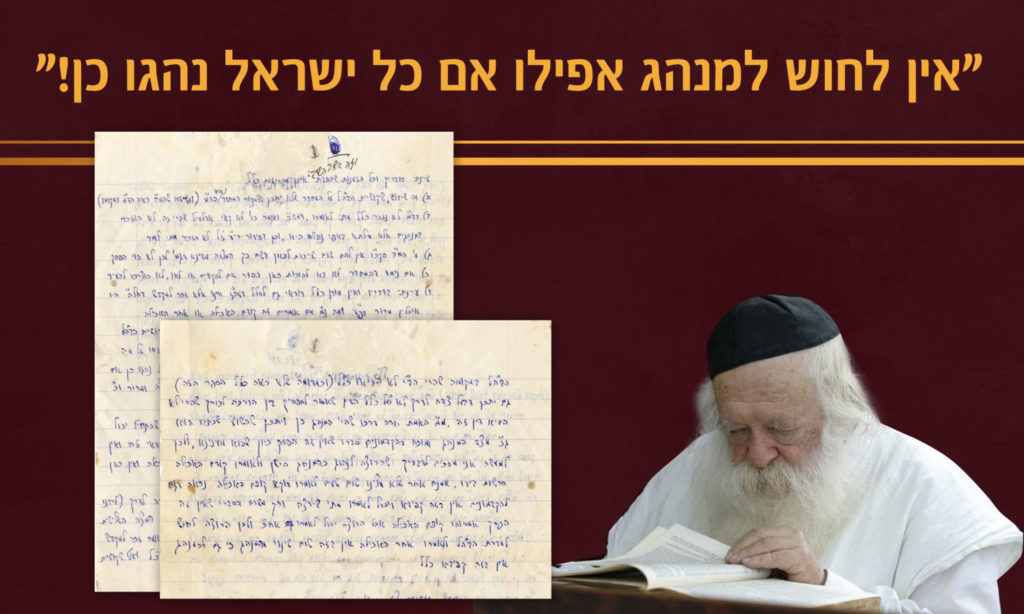
Early halachic responsum, important and rare in its length (approximately 500 words), entirely handwritten by the gaon Rabbi Chaim Kanievsky, who, inter alia, innovates a tremendous novellum in practical halachah – that there is no concern here for the early halachic ruling in Talmud and among the Early Adjudictors [ראשונים] stating “minhag overrides halachah”!
This responsum was apparently written in response to a Torah scholar who criticizes Rabbi Chaim Kanievsky’s first book, Shoneh Halachot . The questioner objects to the words in Rabbi Kanievky’s book (Hilchot Pesach section 475) where he states that on Seder Night, only after korech is consumed does one recite the “Zecher L’Mikdash K’Hillel” text and not, as in the widespread custom, before it is eaten. The questioner brings 10 proofs against Rabbi Chaim’s words, maintaining that it is preferable to recite this text before eating and not after. The gaon Rabbi Chaim, as was his way, with tremendous clarity, respectfully yet firmly, rejects his critic’s proofs one after the other.
One of the questioner’s proofs was apparently the halachic rule based in Talmud and Early Adjudicators: “Minhag overrides halachah” [in Yiddish: א מנהג ברעכט א דין]. That is, due to the fact that the widespread custom is to recite the ‘Zecher L’Mikdash K’Hillel’ text before eating, custom prevails and it is not to be changed. In paragraph 8, Rabbi Chaim responds to this claim and pens a huge practical halachic innovation: This rule is not always valid! And if the custom is not according to the Law, it is not to be considered even if the entire Jewish people follows this custom! In paragraphs 9 and 10, Rabbi Chaim intensifies this novellum and writes that one who recites the ‘Zecher L’Mikdash K’Hillel’ text after eating is not considered one who is diverging from the customs of his fathers, and this even includes those whose families conduct themselves according to the early custom, to recite this text before eating. Given that [we] have found no halachic reason for why it should be recited specifically before eating, this is not considered a custom, and one who diverges from it is not considered one who has diverged from custom.
[2] pp, approximately 15×19 cm. Lined notebook paper, entirely handwritten by Rabbi Chaim Kanievsky.
Fine condition: Aging and damp stains.

Lengthy halachic list (10 sections, over 36 lines) handwritten by the Chassidic “Posek, ” the mighty gaon Rabbi Shmuel HaLevi Wosner, on the topic of the removal of the remains of Sarwasch Jews who were killed during the Holocaust, for reinterment in the Land of Israel.
Written in section 5: ‘… What appears to be proper according to the evidence is that the rabbi of Sarwasch, who was the Av Beit Din and rabbi of the community that was killed, and was also present when they were reburied – changed his mind, saying that if he were asked, he would not allow individuals to remove the remains from their graves …’
Rabbi Simchah Ernster, who apparently dealt with the issue, is also mentioned.
Refer to the Hebrew catalog text for a brief biography of Rabbi Shmuel HaLevi Wosner .
[1] leaf (two written pages). 23×15.5 cm. Official stationery blank of the Torah institution led by his son, R’ Ben Tziyon Ya’akov Wosner. Autograph with supplements, erasures and corrections.
Very fine condition. Fold mark. Slight creases, unnoticeable. Small ink smudges.
Pay Attention: VAT should be added to the commission for foreign residents as well.
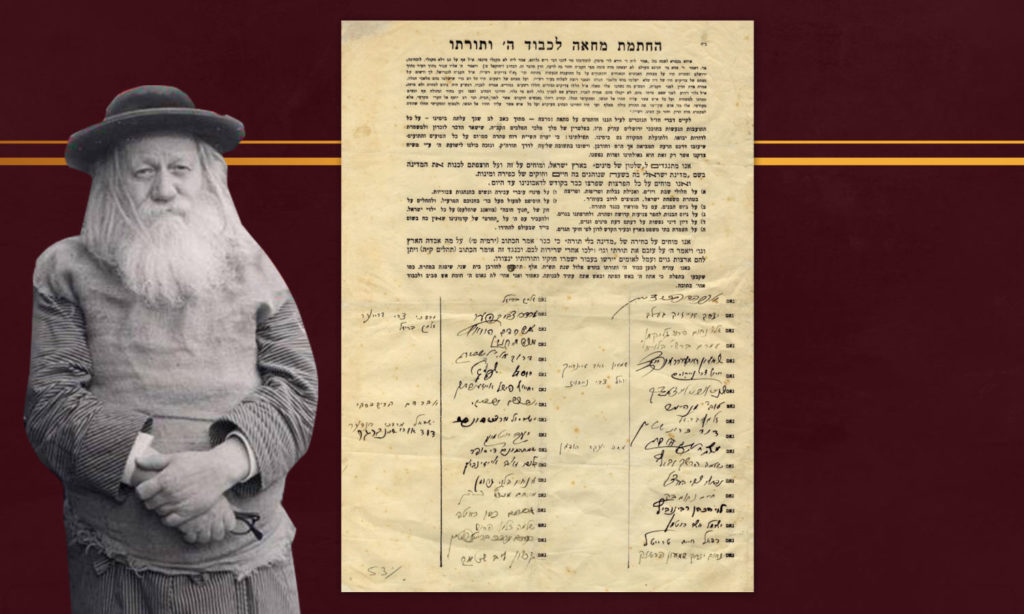
Unknown proclamation signed by approximately 20 personages of the Old Yishuv who vigorously opposed the the very establishment of the state. There was much chaos in the Land in those days around the War of Independence, which started in the winter of 1947 and lasted about a year, into the winter of 1948.
The first stage of the war started in January 1947, immediately following the UN General Assembly’s approval of the partition plan. The Arabs in the Land then began murderous attacks against the Yishuv. The second and more serious stage of the war began the day after the Yishuv leadership announced the establishment of the Jewish state in the Land (May 14), and much blood was shed in the Land.
In Elul 1948, with artillery shells still shaking the Land, the above mentioned personages signed a “Protest in Honor of Hashem and his Torah, ” in which they make it clear that they do not recognize a “state” that has etched its laws counter to the laws of the Torah. They list: Desecration of Shabbat and festivals, forbidden foods, drafting boys and girls, courts opposed to the Torah laws, the appointment of lawbreakers and women to positions of community leadership and the compulsory education law.
Among the signatories, in their handwriting: R’ Eliyahu Nachum Porush, R’ Amram Blau, R’ Zalman Brizel, R’ Levi Rabinowitz, R’ Yisrael Asher Rotman, R’ Nachum Yitzchak Frank, R’ Moshe Mordechai Chanun, R’ Yechiel Fishel Eisenbach, R’ Gershon Shatmer, R’ Simchah Bunim Sofer.
[1] leaf printed paper. 25×35 cm. Original signatures. Fine condition, minimal aging stains.

The heter mechirah controversy:
With the renewal of the Jewish agricultural settlement in the Holy Land, when we were privileged with His help to take hold of the Holy Land with plantations of fields and vineyards, the issue of shemittah came to the fore. Before the seventh year, in 1888, the geonim and rabbis of the Holy Land rejoiced leading up to the fulfillment of the sabbatical of the Land by its children-its builders, those who returned from exile, and they entirely disregarded those who demanded searching for some type of dispensation with various schemes to absolve themselves of this commandment. However the ‘Baron”s clerks and the leaders of ‘Chibat Tziyon’ turned to the rabbinical leaders of Poland, and after they presented them with the danger of extinction of all the colonies and the new settlement should shemittah be observed, the rabbis considered this and found dispensations. Rabbinical leaders of Jerusalem and the majority of rabbinical leaders of Lithuania opposed the dispensation and did not accept it. Beginning in shemittah 1888/9 until this day, every seven years the question of the validity of this dispensation again arises.
Background to the Chazon Ish’s responsum – and the discovery:
In the Kerem Tziyon booklet (booklet 3, Jerusalem 1936), a long article by the gaon of Jerusalem, Rabbi Tzvi Pesach Frank, was printed, in which he sided with those who permit the dispensation. The primary proof brought by the rabbi was “I saw two books released by the study hall, and both as one cancel the dispensation, rejecting it with both hands, and the leaders of the generation who allow it appear to them to be mistaken in their study.” One of the books intended by Rabbi Frank is the Chazon Ish on Tractate Sheviit which was published then, and in the body of the article, he mentions it explicitly. In 1944 Rabbi Kalman Kahane published his Hilchot Shemittat Karkaot which concludes with the article “Birur Halachah” where he disputes Rabbi Frank’s article and vehemently rejects his words – according to this manuscript, it turns out that most of the article was penned by the Chazon Ish who drew his sword against those who support the heter mechirah .
What was known until now was that apparently the Chazon Ish transmitted his words for publication to Rabbi Kahane so that they would be published anonymously, and now it has been clearly revealed that almost all that was printed there is actually the word of the Chazon Ish himself. Before us is the responsum which covers seven pages, in which the Chazon Ish honed his pen and responded sharply, wrote and erased, added and changed, as a warrior in the battle of Torah.
The reaction of the Chazon Ish is divided into three parts:
1) Which facts were presented to the rabbis and how they checked them. Here is a small segment: Rabbi Tzvi Pesach Frank writes at the beginning of the article: “It has become clear for a number of reasons that it is almost impossible that all the inhabitants of the Land will observe shemittah.” The Chazon Ish responds to this: “The method of checking has not been fully clarified, whether it is possible to observe the seventh year or not, the simple basis of the test is whether there is fear [of G-d] in this place. Hence it must not be said that this test showed that it is impossible.” Rabbi Tzvi Pesach Frank wrote, “The question was presented to the leaders of the generation and they decided to permit it, ” to which the Chazon Ish responded, “Where are the sources for all these words that are written, and why have we not merited knowing the names of those who testified before the writer … they surely gave him the names of the members of the investigative committee which was set up by the geonim of the generation … why would the writer ignore all this and write as one of the authors whose words are written without any responsibility …”
2) Who were the rabbis who allowed it, and what was the reasoning of the rabbinical leaders: The Chazon Ish writes: “The geonim who were the rabbinical leaders of that generation, who instructed the generation are about seven: The gaon Rabbi Yehoshua Leib Diskin, the gaon Rabbi Yitzchak Elchanan – Av Beit Din of Kovno, the Netzi”v of Volozhin, the gaon Rabbi Yosef Dov of Brisk, the gaon the Av Beit Din of Karlin, the gaon Rabbi Y. Z. Stern – Av Beit Din of Shavel, the Ridba”z – the Av Beit Din of Slutzk. The response to the inquiry was split; the gaon Rabbi Y. E. of Kovno permitted the sale, and the other six mentioned forbade it. According to the well-known rule, halachah is not established according to the individual against the many, hence instruction was disseminated to forbid it. We learn from this that what was written as to what was clarified then – that observing shemittah is impossible – is fabricated.”
3) Basis for the dispensation. The Chazon Ish covers all the halachic topics relevant to the substance of the dispensation: Whether there is acquisition by a gentile to expropriate, etc., whether there is a difference between sale for a short or long period, the prohibition of selling the Land of Israel to gentiles, sale via emissary, financial loss, etc. He rejects them one by one and concludes: “The sum of the matter, when all has been considered, instruction has been given to forbid it by the majority of the generation’s geonim. Their word is as embedded nails, clearly decided, and there is no place for doubting their truth, because their words are aligned and enlighten all intelligent people, and sheviit is conducted in our times …”
The Chazon Ish’s responsum was printed, as stated, in the aforementioned Hilchot Shemittat Karkaot , with many omissions and in a different version, possibly according to a different manuscript, in Chazon Ish Shu”t V’Chiddushim (Bnei Brak 2016) siman 351.
Complete and continuous responsum in the Chazon Ish’s own handwriting, with no changes to language or style – This precise format has never been printed!!
This is aside from the essence of the discovery that all that Rabbi Kalman Kahane wrote in Birur Halachah at the end of his book, is actually comprised of quotations from the Chazon Ish’s responsum, as he was requested by the Chazon Ish to conceal his authorship of what was written.
7 pages. Ink on notebook paper. 22×14 cm.
Fine condition. Professional restoration in the white margins. The ink is faded in a number of places, mainly on the last two pages. Magnificent new leather binding.
Pay Attention: VAT should be added to the commission for foreign residents as well.
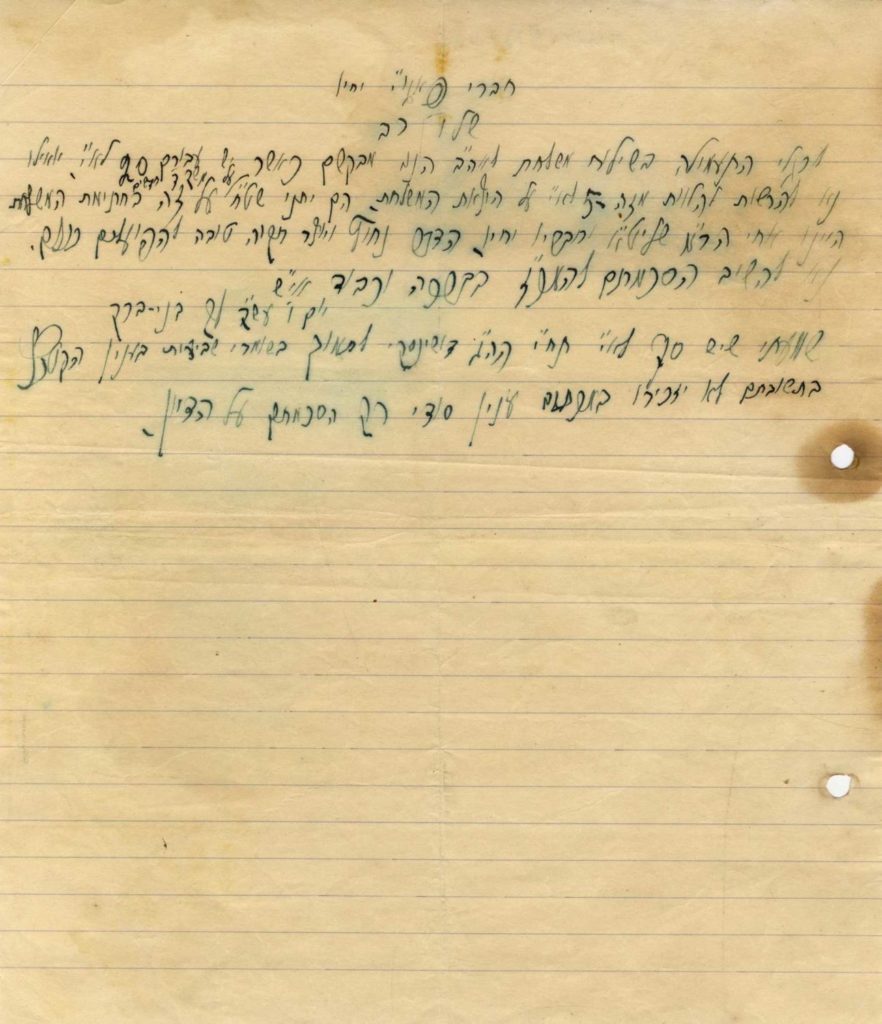
In the letter, the author of Chazon Ish turns to the members of Poalei Agudat Yisrael about the possibility of a monetary loan for sending a delegation to the United States (apparently to fund raise for shemittah observers). He adds that his brother [Rabbi Meir Karelitz, rabbi of PA”Y] will also sign the loan document.
There is a line added at the end of the letter testifying to the Chazon Ish’s multifaceted activity in support of shemittah observers all over the Land of Israel, as he writes:
“They won’t mention the secret issue in the letter, only their agreement to the deliberation.”
It was known that the Chazon Ish was very active promoting Shemittah observance per halachah, without relying on various dispensations, and he stood by the Chareidi settlements that observed shemittah according to halachah. However, here his extensive activity behind the scenes is also revealed.
[1] leaf, 21×25 cm. Entirely in his handwriting with his signature. Fine condition, Filing perforations. Minimal stains.

Important archive regarding the difficult historic episode which shocked the Jewish community in the young State of Israel.
* Poster calling for a worldwide day of prayer on the 10th of Av. Signed by Rabbi Isser Zalman Meltzer, Rabbi Tzvi Pesach Frank and Rabbi Chizkiyah Shabtai, Av Beit Din of the Sephardic community in Jerusalem.
Both Rabbi Isser Zalman Meltzer and Rabbi Tzvi Pesach Frank headed the historic campaign against this law and both met with Ben-Gurion to discuss the matter. Rabbi Isser Zalman was ill and at the very end of his life, but he said that he was willing to suffer and sit in jail, despite his condition, because of the severity of the decree. Rabbi Tzvi Pesach Frank was the rabbi of Jerusalem and a member of the Chief Rabbinical Council. He threw all his weight and influence into this battle. The poster was sent to the Agudat HaRabbanim (Union of Orthodox Rabbis) and to Agudat Yisrael in the United States, to England, and to the Central Rabbinical Council and Young Israel in the United States, with dates when they were sent.
* Poster signed by dozens of rabbis and Admors opposing the draft of girls to National Service. Tammuz, 1953. Signatories include: Ashkenazic rabbis: Rabbi Yerucham Asher Warhaftig, Rabbi Chananya Yom Tov Lipa Gross of Berbești, Rabbi Yisrael Welz, Admor Yochanan of Rachmastrivka, Admor Yochanan of Tolna, Rabbi Eliyahu Zlotnik, Rabbi Bezalel Stern of Pupa (Melbourne), Rabbi Yechiel Michel Shlager and others. Sephardic rabbis: Rabbi Avraham Raful, Rabbi Yehudah Tzadka, Rabbi Eliyahu Moshe Maaravi and others.
* Letter opposing the draft of girls to the National Service from the beit din of the Eidah HaCharedit in Jerusalem. Tammuz 1953. Signed by the Raavad, Rabbi Pinchas Epstein.
* Sharp letter sent to Rabbi Yitzchak Isaac Herzog, chief rabbi, from the sages and yeshivah rabbis in Jerusalem, opposing the Chief Rabbinate’s intention to reopen the discussion about drafting girls. They appeal to Rabbi Herzog not to reopen the subject and not to submit to the pressures of the Mizrachi and the Poel HaMizrachi. 2 leaves, the upper section is typewritten, followed by dozens of rabbinical signatures. Signatories include: Rabbi Zev Eidelman, Rabbi Moshe Yehudah Landau, Rabbi Elkana Wissenstern , Rabbi Nachum Berman, Rabbi Baruch Shimon Schneerson (?) and others. * Letter opposing the National Service signed by Sephardic rabbis in Tel Aviv. * Seven printed letters opposing the draft of girls, signed by prominent rabbis, Admors, Roshei yeshivahs, from throughout the world and all backgrounds. Tammuz, 1953. 7 leaves. Includes dozens of signatures, with slight differences between the leaves. Many of the rabbinical signatures were copied and then the letters were sent so other cities to that additional signatories could be added (includes a short letter that was sent along). Following the printed signatures there are additional handwritten signatures, including those of: Admor Yosef Tzvi of Skierniewice (Bnei Brak), Rabbi Shmuel HaLevi Wosner, Rabbi Aharon Tzvi Brisk (Tășnad), Rabbi Daniel Movshovitz, Rabbi Avraham England, Rabbi Tzvi Markowitz, Admor Rabbi Shalom Michlowitz, Rabbi Peretz Ariel and more.
* Protocols of meetings between rabbis, members of the Council of Rabbinical Sages, and Prime Minister David Ben-Gurion and President Yitzchak Ben Tzvi. Tammuz, 1953. 4 leaves (photocopy).
* Documents regarding a religious girl who did not pass the exemption committee and was obligated to enlist. 1957. The girl’s declaration. Letter from Rabbi Moshe Aryeh Leib Shapiro, who knew the girl personally, and signature of Rabbi Yitzchak Yaakov Wachtfogel. The document also bears signatures of many of the girl’s neighbors and a confirmation from Rabbi Moshe Leib Shapiro.
Overall fine condition.
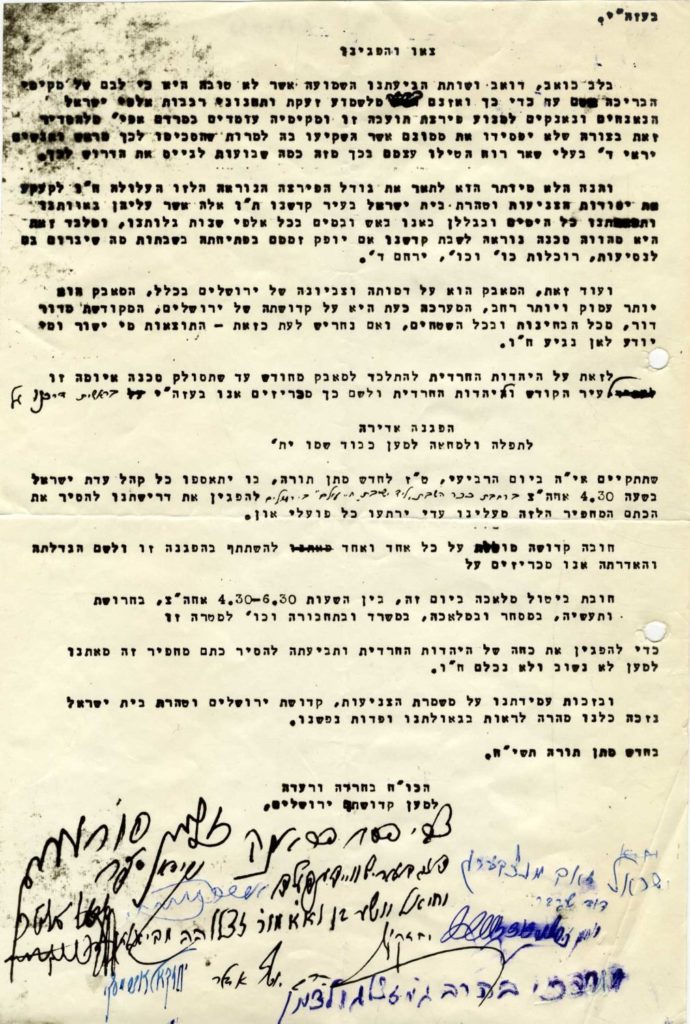
* Poster protesting the opening of a mixed swimming pool in Jerusalem, [1958].
Get out and protest – poster calling for a protest against the mixed swimming pool in Jerusalem. The original poster was signed by a number of rabbis. It was then copied, and then signed by additional rabbis in blue pen, including: Rabbi Yechezkel Abramsky, Admor Yochanan Twersky of Rachmastrivka, Admor Avraham Weinberg of Slonim, Admor Mordechai Goldman of Zhvil, Rabbi Yisrael Ze’ev Minzberg and Rabbi David Sperber.
This historic episode was one of the events that formulated the relationship between the Ultra-Orthodox community and the nascent Israeli government.
[1] leaf paper 30×20 cm. Very fine condition. Filing holes
* Poster supporting Agudat Yisrael in the Be’er Sheva municipal elections. [1963]
The poster was signed and stamped by Rabbi Ezra Attiyah, Rosh Yeshivah of Porat Yosef; Rabbi Yosef Zelm Rosh Yeshivah of Porat Yosef; Rabbi Zalman Sorotzkin; Rabbi Yosef Naftali Stern; and Rabbi Yosef Adler of Turda.
[1] paper. 21×33 cm. Very fine condition. Filing holes.
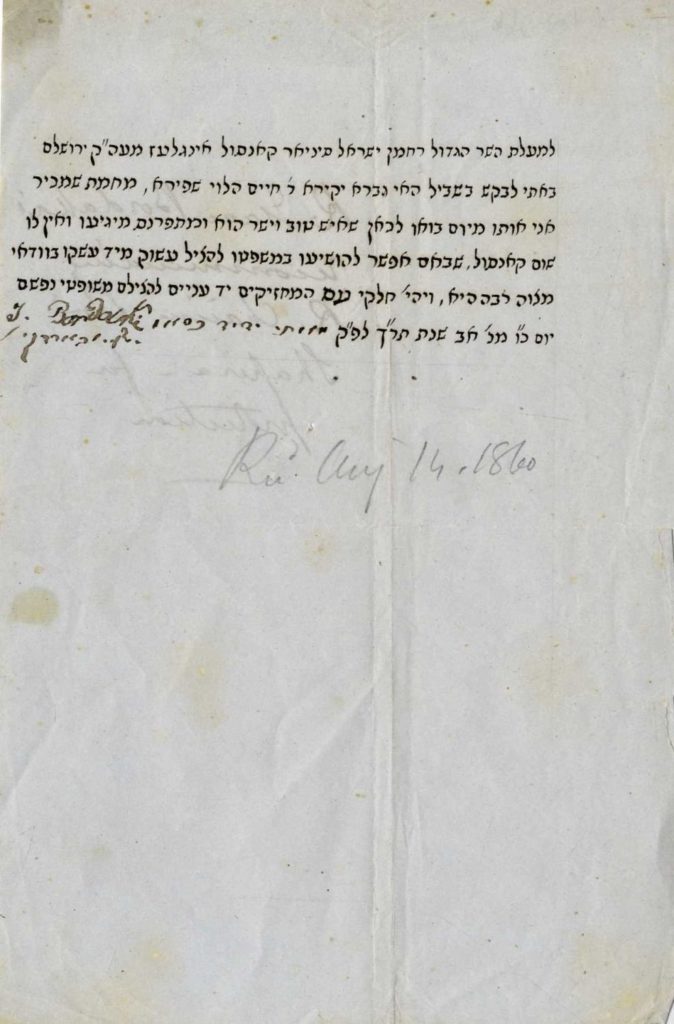
Rabbi Yeshayah was a Pinsk native; he was Rabbi Chaim of Volozhin’s primary disciple. He moved to the Land of Israel in 1810 and settled in Safed. He then moved to Jerusalem, and was one of the first Ashkenazim, headed by Rabbi Menachem Mendel of Sklow, to revitalize the Jerusalem community. He married Rabbi Yisrael of Sklow’s daughter in 1823, and inherited the Jerusalem community leadership after his father-in-law’s passing in 1839. The consuls appointed him their representative in the city, which granted him much power. As a representative of the consuls, R’ Yeshayah was privileged to work alongside the Ottoman government, and he led the community courageously.
When the Crimean War broke out and the yishuv was disconnected from its European sources of support, a crisis developed, as many families were in danger of starvation. Astonishingly, Finn assisted the yishuv and called for friends abroad to send donations. When the funds were found to be insufficient, they were even willing to take loans with high rates of interest! The situation got even worse in the harsh winter of 1854, when the economic situation was compounded by the freezing cold and snowstorm. Finn distributed bread twice a week and he also distributed coal. Hundreds of people streamed to his house to receive bread. Astoundingly, his charity met with the opposition of Rabbi Yeshayah Bardaki. He appealed to the community not to need this assistance as he was concerned that it was fueled by missionary intentions. Finn wrote in his diary (manuscript): March 1, 1854: “Last Shabbat, R’ Yeshayah spoke in the synagogue and claimed: due to the sin of taking charity like this from Christians, the coming of messiah is being delayed”.
This letter contains the first disclosure of a direct appeal by Reb Yeshayah to Finn in 1860, asking for help “for the dear … Reb Chaim HaLevi Shapiro … whom I have known since his arrival here …”
[1] leaf. 21×14 cm. Scribal script with a handwritten addition in his own hand: מאיתי ידי כסאו, and his Hebrew and English signatures. Fine condition.
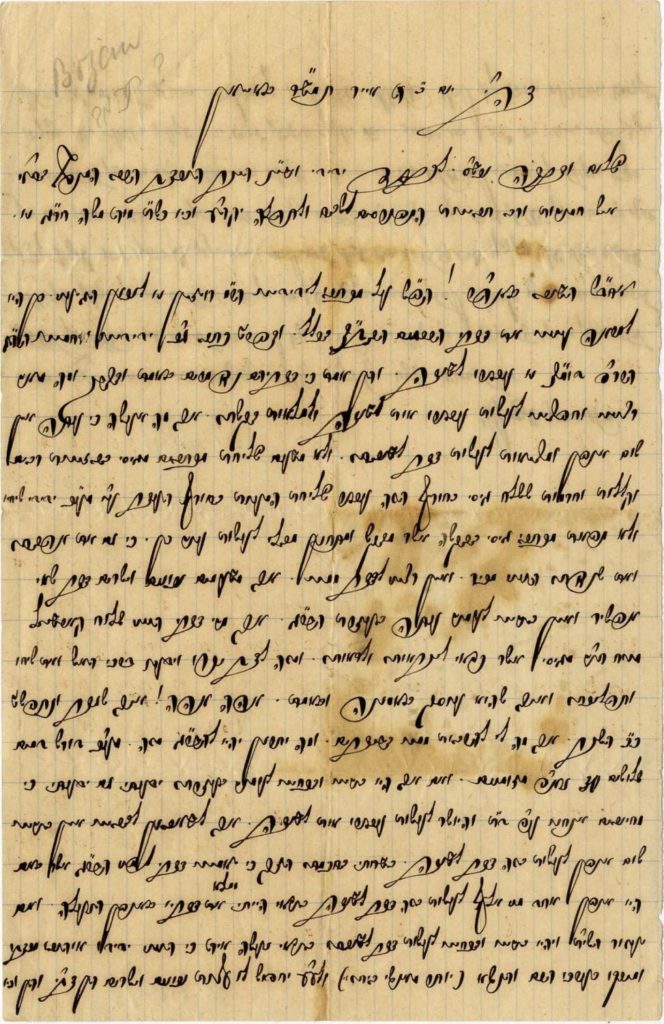
Rabbi Moshe Zev Neched was one of the leaders and glory of the group of Boyan Chassidim in Safed. He cleaved himself to the Admor of Sadigura and his son, the Pachad Yitzchak of Boyan.
Rabbi Moshe Zev was born in Safed in 1855. His father was Rabbi Yechiel Dov, who named him for his grandfather, Rabbi Moshe Zev Auerbach of Chmielnik. He married Sarah Rachel daughter of Rabbi Shalom Meir, son of the righteous Rabbi Avraham Shlomo , son of the holy Rabbi Yisrael Chaim of Ludmir, son of Rabbi Avraham “the angel” and son-in-law of Rabbi Shlomo of Karlin.
In Safed, Rabbi Moshe Zev warmed himself by the light of the chassidic leaders, by the Saba Kadisha of Ruzhin and his son Rabbi Avraham Yaakov of Sadigura. As just a young man, Rabbi Moshe Zev already stood out as a role model among the cadre of the Chassidim in Safed.
[1] leaf. 22×14 cm. All in his hand and with his signature. Fine condition. Aging stains.
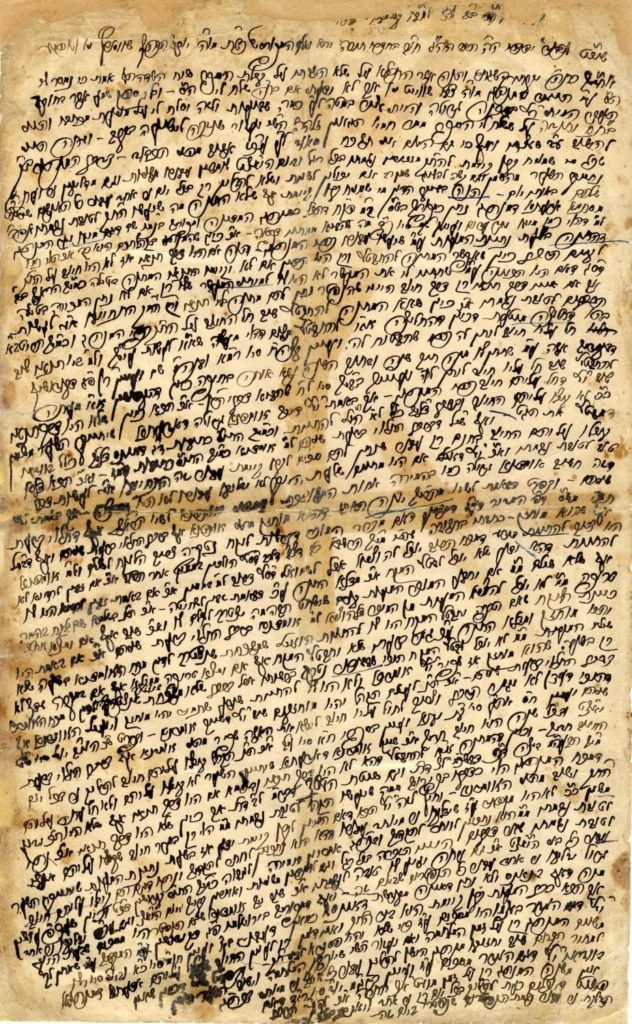
Long letter addressed to Rabbi Yosef HaCohen Schwartz, one of the greatest scholars of Hungary and editor of the well-known periodical VaYelaket Yosef, containing a discussion about the customs of yahrzeit, which diverts, in the manner typical of Torah discussions, into the laws of divorce documents and of commerce.
Rabbi Shmuel Engel , the gaon of Radomyśl, (1853-1935), was Av Beit Din in Galicia and later in Košice, where he devoted himself to finding ways to permit the agunahs of World War I. He authored Shu”t Mahara”sh , 8 sections, Siftei Mahara”sh and Chiddushei Mahara”sh . His rabbi was Rabbi Chaim Halberstam, the founder of the Sanz Chassidism. He was ordained as a rabbi by Rabbi Yosef Shaul Nathansohn (the ‘Sho’el UMeshiv’) and Rabbi Shneur Zalman Fradkin (the ‘Torat Chessed’). He was one of the greatest responders of his generation and all the rabbis of the generations and greatest Admorim appealed to him with halachic questions.
[1] leaf. Ink on paper. 33×20 cm. Entirely handwritten and signed by him. On the other side of the leaf, he added a line and signed his name.
Moderate-fine condition. The letter has been professionally restored. Light tears damaging the uppermost line. Except for a few words, everything is legible.
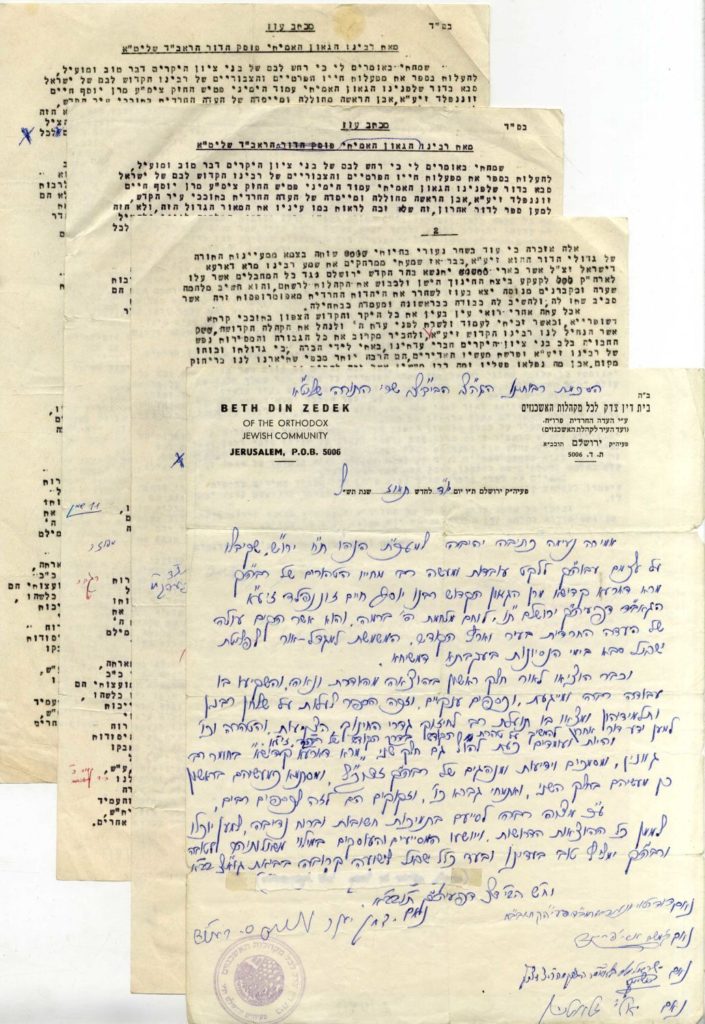
Two letters of blessing and support from rabbis of the Eidah HaCharedit in Jerusalem. 1970. Written for the publication of the second section of Mara D’Ar’a Yisrael with facts and conduct of the esteemed rabbi of Jerusalem, Rabbi Yosef Chaim Sonnefeld. The letters are signed by Rabbi Yitzchak Yaakov Weiss, Raavad of the Eidah HaCharedit; Rabbi David Jungreis, Raavad of the Eidah HaCharedit; Rabbi Moshe Aryeh Freund; Rabbi Yisrael Moshe Dushinsky and Rabbi Eliyahu Zlotnik.
Rabbi Yosef Chaim Sonnenfeld [1848-1932] was the first rabbi of the Eidah HaCharedit in Jerusalem. His biography was written by Menachem Mendel Gerlitz and Rabbi Yosef Moshe Sofer. These two letters recommend supporting the publication of the second volume of the book.
[3] typed pages and [1] handwritten in ink on paper. Various sizes. Overall fine condition. Minimal tears, without loss.
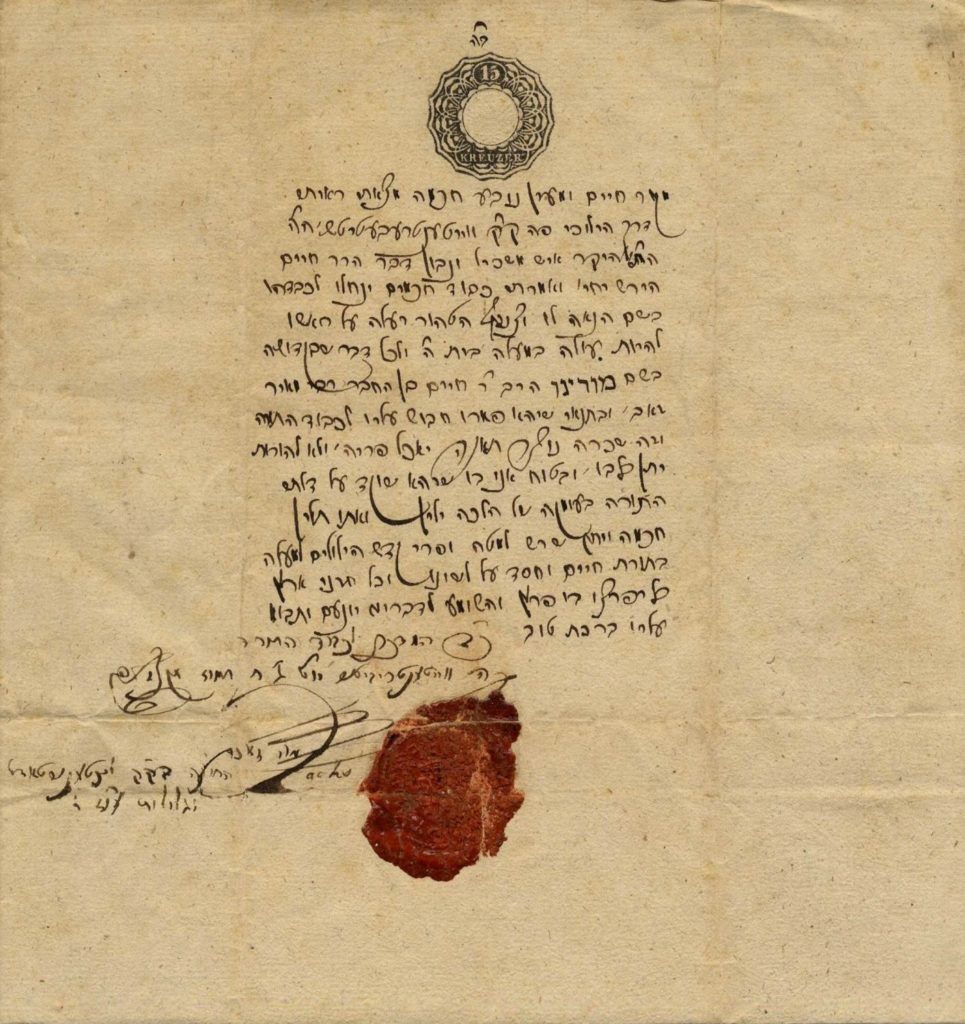
“… I have found and seen the path of halachah here in Weitenterebetrach … the wise and understanding … Chaim Hirsch … henceforth to be called Moreinu R’ Chaim Hersch son of R’ Meir Zev …”
Rabbi Moshe Zaks, Av Beit Din of Lichtenstadt and region, was born in Prague. He studied under Rabbi Shmuel Leib Kauder, author of Olat Shmuel , and served as Av Beit Din of Lichtenstadt and the neighboring Karlsbad. Many Hungarian and Polish rabbis who came to the Karlsbad resort enjoyed speaking about Torah and halachah with him. At the end of his life, he left the rabbinate and moved to Vienna. Refer to the preface to Sefer HaMor Dror – HaMamarim V’HaDrashot – for praise of this personality.
[1] folded paper. 21×34 cm. Beautiful hand, signed by Rabbi Moshe Zaks, Av Beit Din of Lichtenstadt and region. With traces of a wax seal. Very fine condition.
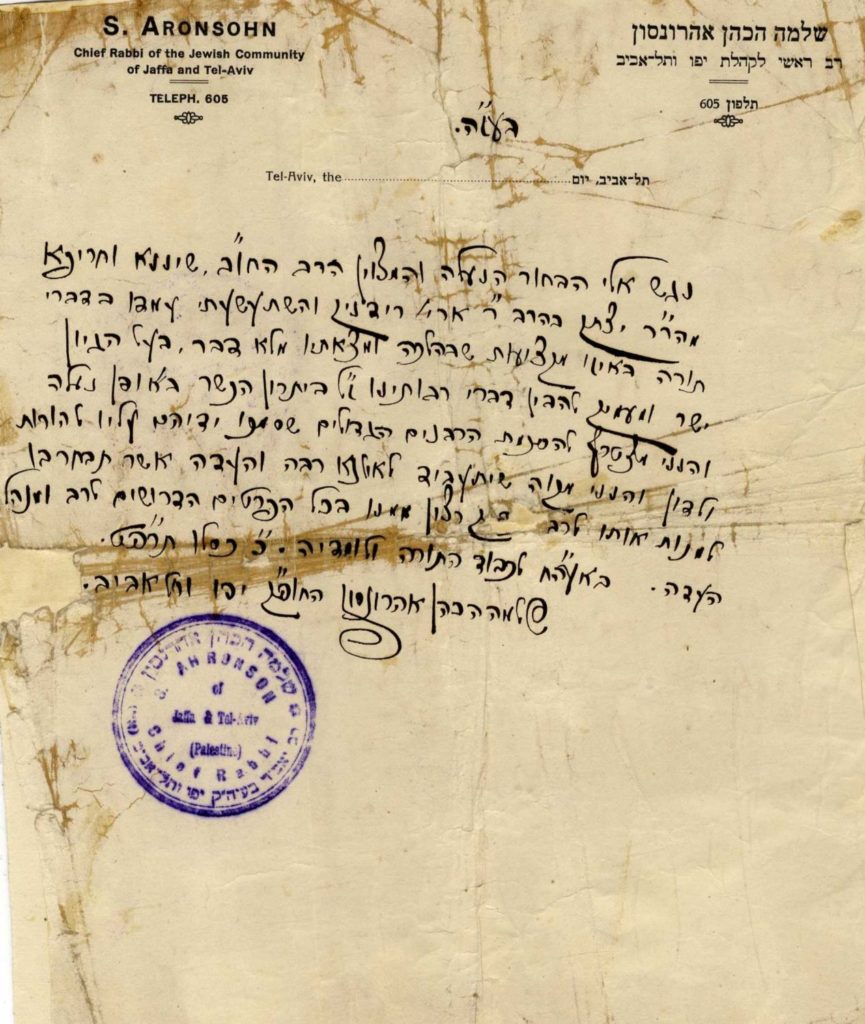
Four ordination letters from the following rabbis: Rabbi Yechiel Michel Ze’ev Horowitz, Rabbi Ben Tziyon Meir Chai Uziel, Rabbi Yosef Tzvi HaLevi, and Rabbi Shlomo HaKohen Aharonson. Including letters bestowing rabbinical ordination upon Rabbi Yitzchak Rudnik, who studied for approximately five years in a yeshivah in Jaffa, and later served as rabbi in London; he authored Sdeh Yitzchak .
The rabbinical letters describe Rabbi Yitzchak Rudnik as “sharp and knowledgeable in the realms of Torah, analytical logic and understanding; he delves into the depths of halachah, and excels in straightforward, sharp thinking … a Torah great, a prominent rabbi of our times.” It additionally notes that he is worthy of contributing to halachic deliberations and offering rabbinic decisions.
[4] paper leaves. Various sizes. All were handwritten, signed and stamped by the rabbis bestowing the ordination. Pasted onto canvas. Overall moderate-fine condition.
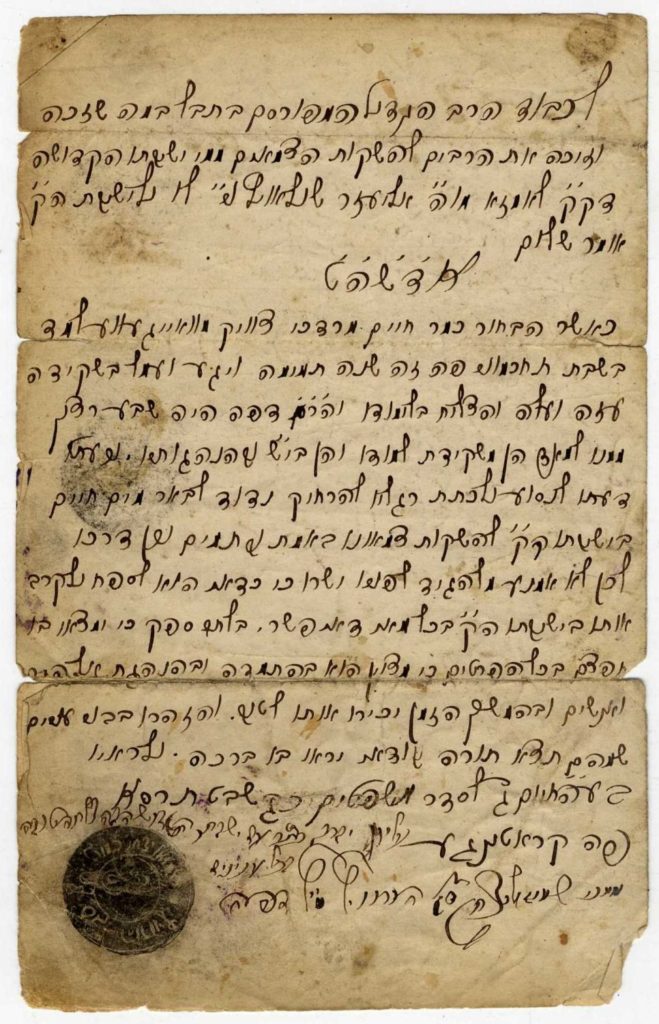
Ritual slaughter permits for the youth Chaim Mordechai Tzwuek of the city of Vaiguva, by the rabbis:
The gaon Rabbi Shmuel Yitzchak Horowitz, adjudicator in Krattigen beginning in 1901. Otzar HaRabbanim 19575. The ordination was sent to the gaon Rabbi Eliezer Sholvitz, the founder and head of the Lomzhe yeshivah in Lithuania and later in Petach Tikvah.
Rabbi Yehudah Leib son of Eliezer, prayer leader and ritual slaughterer and checker in Potawein, in 1903.
The well-known gaon Rabbi Ephraim Dobver Berzinski, rabbi in Vaiguva and author of the book Sefer Plitei Ephraim , sermons on the Torah, in 1904. Otzar HaRabbanim 3088.
The gaon Rabbi Yisrael Yehoshua Segal-Melamed, of Cytowiany in the district of Kelm in Lithuania, served as a rabbi in Varena in 1903. Otzar HaRabbanim 12210.
Rabbi Yechiel Michel Mushkin of Jerusalem, author of the books Meichal Mayim Chaim , Milei DeAvot and Michlal Yofi , in 1909.
5 leaves. Ink on paper. 3 of them are mounted on cardboard. 13×21 cm. All of them signed autographs. Ashkenazic scripts. Moderate-fine overall condition. In an original notepad with laces for tying.
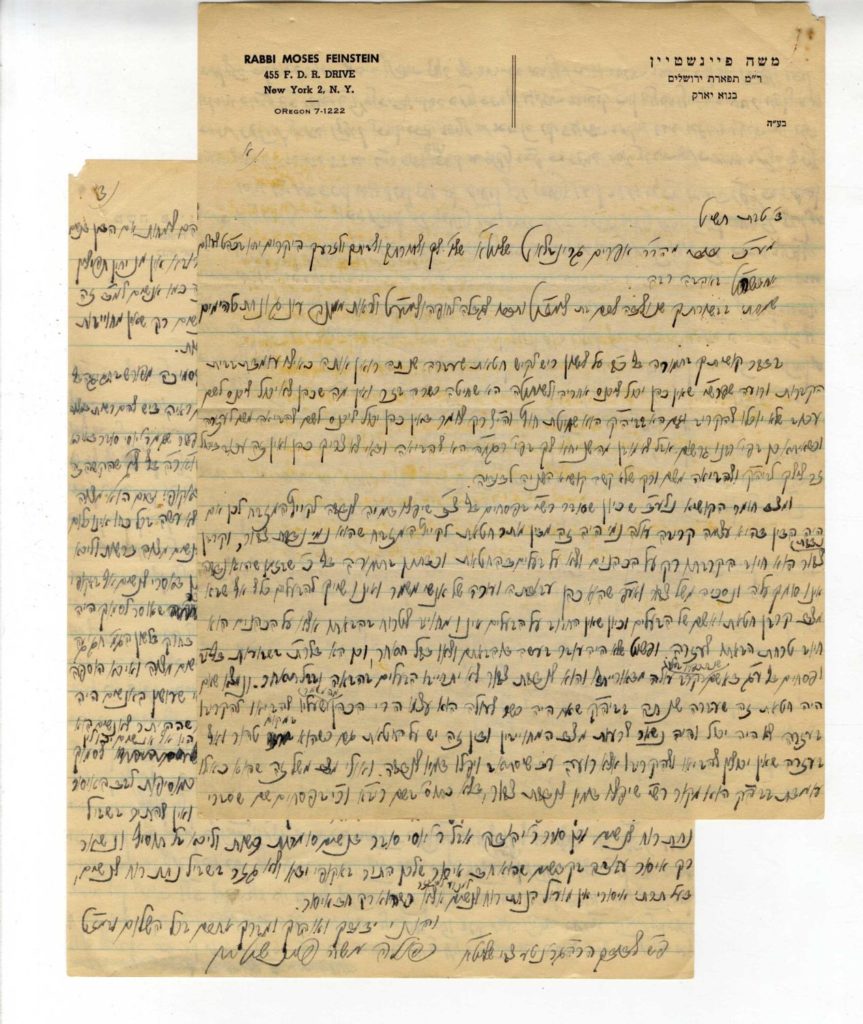
Letter containing a lengthy responsum handwritten and signed by Rabbi Moshe Feinstein. New York, 1959.
The responsum was sent to his renowned disciple, Rabbi Ephraim Greenblatt, and is comprised of two parts, on two subjects. The first, on the topic of Kadshim, is unprinted! The second was printed in Iggerot Moshe Orach Chaim II, section 2. 4 pages. Lined paper blanks. 28×21 cm. Erasures and corrections, entirely handwritten and signed by Rabbi Moshe Feinstein. Very fine condition.
Rabbi Moshe Feinstein [1895-1986] was among the greatest halachic adjudicators in the period following the Holocaust, chairman of Agudat Yisrael’s Council of Torah Sages in the United States and head of Mesivtha Tifereth Jerusalem in New York. He is also known for his series of books, Shu”t Iggerot Moshe .
Rabbi Ephraim Greenblatt [1932-2014] was a halachic adjudicator and author of the Rivevot Ephraim responsa. He was a renowned halachic adjudicator, and Rabbi Moshe Feinstein’s primary disciple.
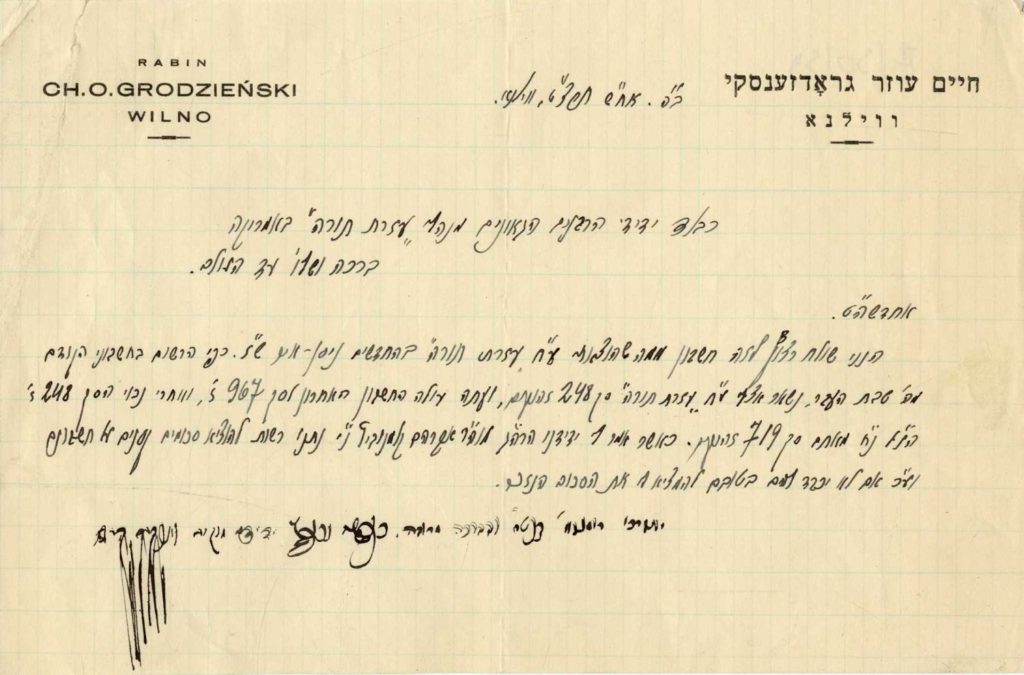
Two letters with the handwritten signature of Rabbi Chaim Ozer Grodzinsky and financial documents that were sent to the managers of Ezrat Torah in America. [1939]
* Letter to the managers of Ezrat Torah in America detailing the expenses and income of Ezrat Torah for the months of Nissan-Iyar 1939. Written on official stationery and signed by Rabbi Chaim Ozer Grodzinsky.
* Attached to the letter, there is a detailed expense account with the names of the receiving rabbis, also written on the official stationery of Rabbi Chaim Ozer Grodzinsky with an additional copy of the list on regular paper. The list includes the names of important rabbis and we shall note anecdotally the expenses for a rabbi who paid an attorney to represent his son who was on trial for refusing to eat non-kosher food in the army.
* Long detailed letter to the managers of Ezrat Torah with detailed requests for special cases that require special expenditures. Written on official stationery, Tammuz 1939. Signed by Rabbi Chaim Ozer Grodzinsky.
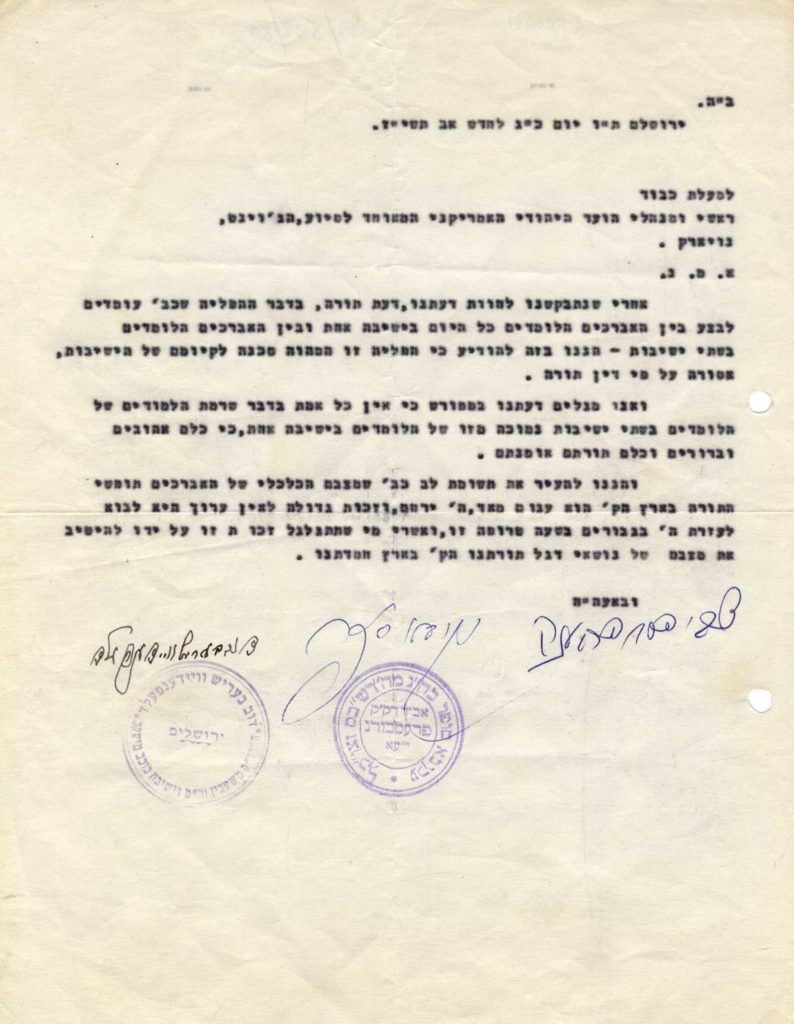
The letter was sent to the Joint Distribution Committee – “the Joint.” The rabbis write that their opinion was requested regarding whether there is a difference between avreichim who learn all day at one yeshivah and avreichim who learn at two locations. The rabbis determine that there is no difference between them, and if there is discrimination between them, the matter would constitute a danger to the existence of yeshivahs. The rabbis also add that the financial situation of the avreichim is very bleak, and it is a great privilege to assist them.
[1] leaf paper. 28×22 cm. Copy paper signed by the rabbis, with their stamp. Very fine condition. Filing holes.
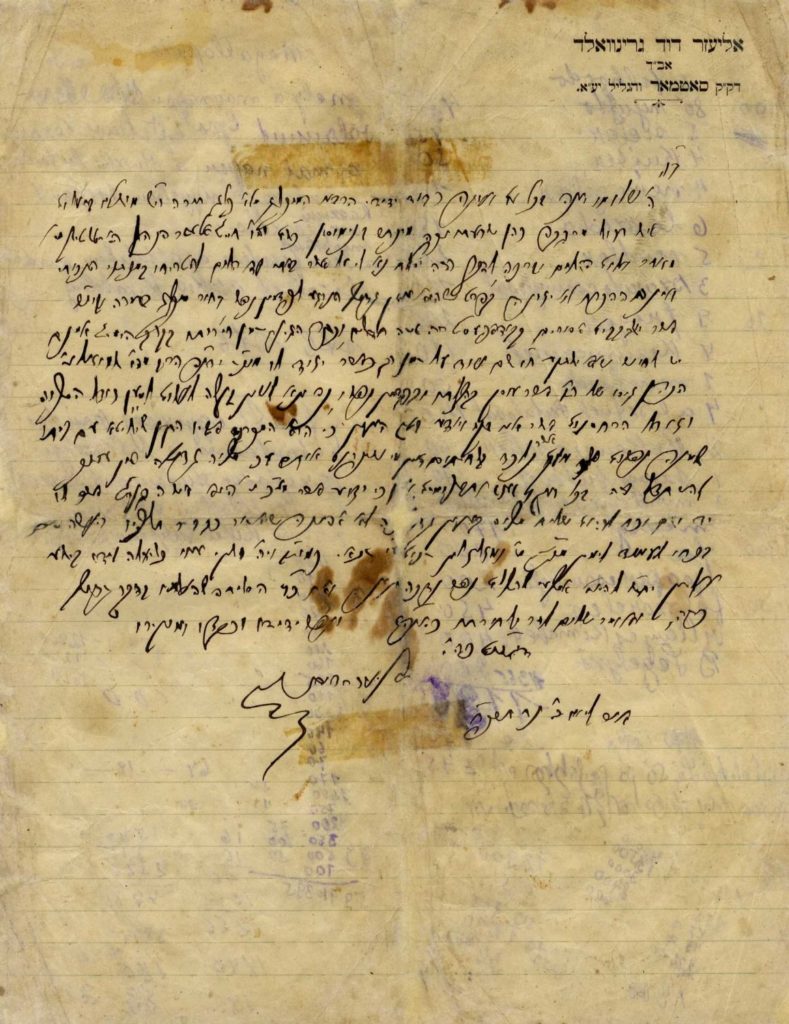
Letter appealing for assistance for the mitzvah of redeeming a captive, a young man imprisoned in Budapest without anybody to support his family: “… A young man who is well-versed in Torah and fear of G-d is imprisoned in Budapest for six months and it is time for him to be redeemed … we must worry that he will be stuck there … because he supports his elderly father … with his home with eight souls … and there is nobody to support them, therefore it is a big merit to try to help with all one’s might.”
Rabbi Eliezer David Greenwald (1867-1928) was born in Csorna, Hungary. His father was Rabbi Amram Greenwald, son of Rabbi Yosef Greenwald, Av Beit Din of Sečovce . In his youth, he studied under his brother, the author of Arugat HaBosem , and is considered his most dedicated disciple. He studied for a short time under Rabbi Shmuel Ehrenfeld, author of the Chatan Sofer . He served as rabbi and rosh yeshivah in Tzehlim (today Deutschkreutz, Austria), Oberwischau and Satmar, Transylvania. He was one of the most prominent Torah sages of his time and taught many disciples, including many noted Torah scholars and rabbis in Transylvania and Hungary. He is known by the title of his work, Keren L’David . His letters are very rare.
[1] leaf, stationery. 30×22 cm. About 17 lines in his hand, with his signature. Moderate-fine condition. The letter was professionally restored, with a slight blemish to the text.

Letter handwritten and signed by Rabbi Yisrael Ber Odesser to Rabbi Shmuel Horowitz. Tiberias, 1933.
Lengthy and interesting letter sent by Rabbi Yisrael Ber [Dov] Odesser to Rabbi Shmuel Horowitz, who was among the important leaders and men of influence (mashpi’im) of Breslov. In the letter, Rabbi Odesser writes regarding himself: “I have not yet merited joy, and am still undergoing what is happening from all sides” as well as about the importance of seclusion (hitbodedut), and on the topic of printing Breslov books.
Rabbi Yisrael Ber Odesser was born in 1886 to a family of Karlin Chassidim in Tiberias. As a child, he found the book Hishtapchut HaNefesh in a genizah. However, the book was without a binding, and he did not know who the author was. He got excited about the book, studied it regularly, became a Chassid of Breslov and resided nearby and inside the neighborhood of Rabbi Mordechai Chaim Slonim, who drew him close and arranged a place for him to live despite the fact that he belonged to the Slonim Chassidut, which opposed Breslov Chassidut. Over the course of time, a group of Chassidim gathered around him to learn with him. Towards the end of his life, he became well-known following a mysterious letter on a note reading “נ נח נחמ נחמן מאומן.” As such, he is know by his followers as “Ba’al HaPetek.” The letter was sent to Rabbi Shmuel Horowitz, who was a Breslov mashpia.
[2] pages, on one leaf folded in two. 22×27 cm. Entirely handwritten by him and with his signature. Signed “Yisrael Breslov.”
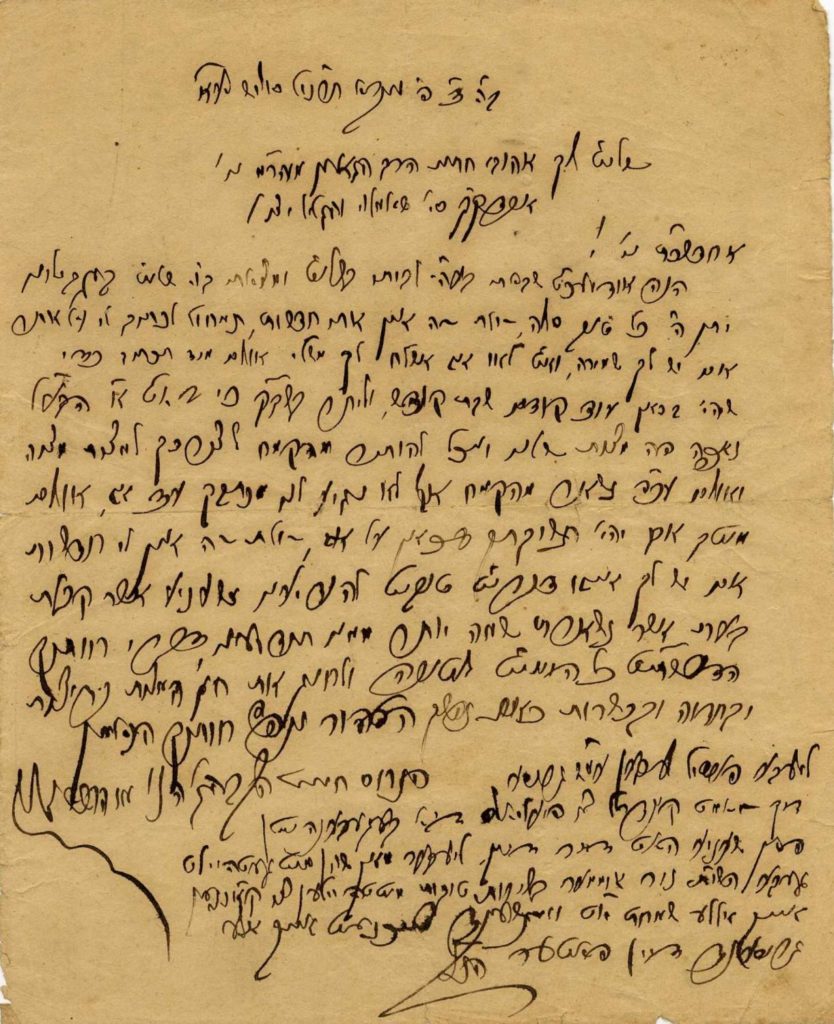
Familial letter. There is a list of sources on the reverse, apparently preparation for a sermon.
Rabbi Pinchas Chaim Klein was the son of Rabbi Shmuel Shmelke Klein, rabbi of Selish. He studied under the Ktav Sofer, and succeeded his father as rabbi of the city in 1875. He passed away in 1923. He was related through marriage to Rabbi Yosef Nechemiah Kornitzer, rabbi of Krakow.
Rabbi Moshe Chaim HaLevi Litsch-Rosenbaum was the rabbi of Kleinwardein beginning in 1897. When he wrote this letter in 1891, he was serving as rabbi of Şimleu. He authored Lechem Rav, Livyat Chen and more.
[1] leaf. Ink on paper. 17×21 cm. Fine condition. Light tears without loss.
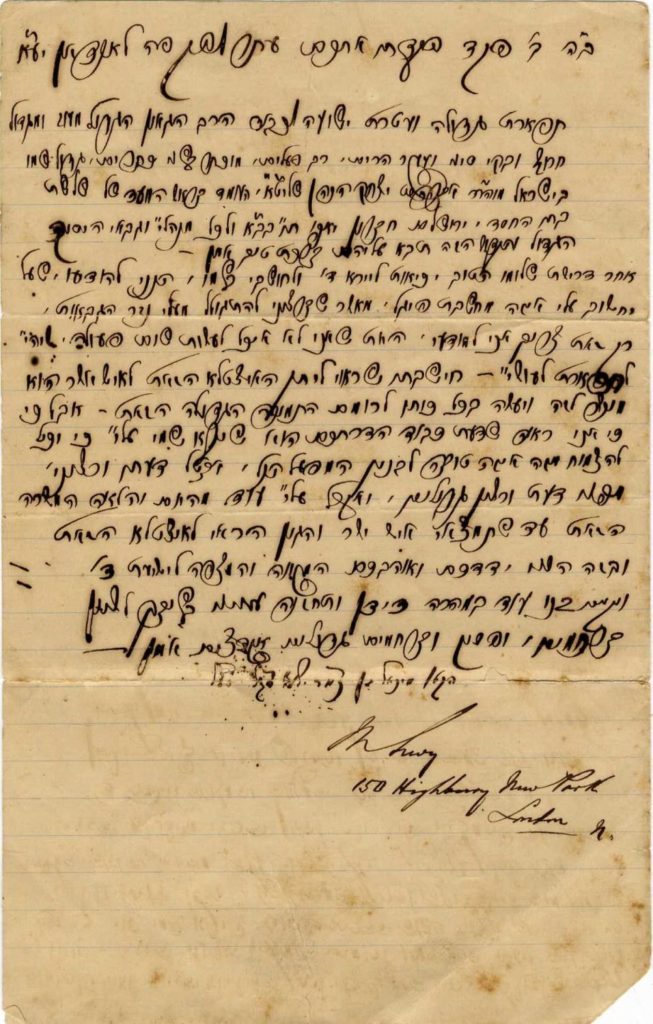
The letter starts with many praises for Rabbi Kook: הרב הגאון הגדול מעוז ומגדול חריף ובקי סיני ועוקר הרים. Rabbi Levi then declares that he cannot accept the task of gabbai. “It is worthy to give this position to someone … who will do all that he can to uplift this great endeavor.”
Rabbi Levi served as rabbi in London, and was Rabbi Shimshon Rephael Hirsch’s son-in-law.
[1] leaf, paper. 13×20 cm. Ink on paper. Moderate-fine condition. Fold marks. Tears in the folds without loss. Tiny holes from the acidic ink.